Early Gas Stations
The distribution of gasoline and other automotive supplies and services was the subject of intense competition among the various major companies. The government tried to regulate these activities in various ways none of which worked very well. When the government attempted to force major companies to split into geographic sub-entities, many just created front companies and continued along their normal business patterns. As a part of this competition the various oil companies began to have specific designs for their buildings and the franchise dealers selling a particular brand of fuel/products would often have very attractive buildings that followed the company style, thus drawing customers by the familiarity of the establishment’s appearance.The first service stations were usually old time machine and welding or blacksmith shops that had evolved through the years of horse drawn buggies and farm equipment and naturally began to handle motor car supplies. This started with barrels of fuel and oil and progressed to the installation of visible gas pumps out at the curb and then to specialized buildings with pumps located back from the street.
The information on this page is intended to illustrate some of those first gas stations and their specialized design for a particular company. In many cases the design was determined in part by where the stations was located as well, incorporating a geographic influence along with or instead of the corporate style.
The webmaster welcomes the submission of additional photos of Montana stations and their related history. Not all of the photos below are from Montana, but each one illustrates a particular style or “fashion” influenced by the major oil companies or in some cases the political or social events of the time.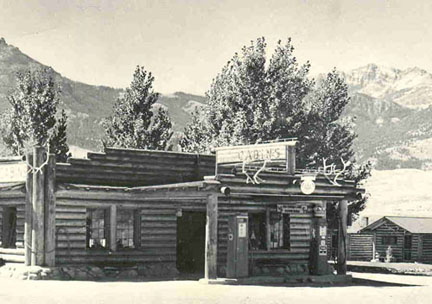 A Standard Station in Gardiner, Montana, could well have been a 1920’s station or from any decade through the 1970’s.
It is of log construction in a sort of “Old West Design” or “Western Mountain States Style” that exemplifies what tourists still find fascinating. The elk antlers on the buildings add to the atmosphere.
There is a cabins sign on the roof and there are log cabins visible in the background. Note also the AAA sign and the crown on the gas pump. It is equally revealing that there
are none of the now common automotive supply signs for tires, oil or food items. There is also no indication that any type of repair work is offered.
A Standard Station in Gardiner, Montana, could well have been a 1920’s station or from any decade through the 1970’s.
It is of log construction in a sort of “Old West Design” or “Western Mountain States Style” that exemplifies what tourists still find fascinating. The elk antlers on the buildings add to the atmosphere.
There is a cabins sign on the roof and there are log cabins visible in the background. Note also the AAA sign and the crown on the gas pump. It is equally revealing that there
are none of the now common automotive supply signs for tires, oil or food items. There is also no indication that any type of repair work is offered.
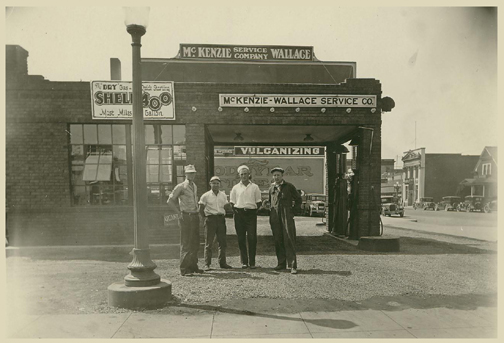 McKenzie Wallace Service Company Gas Station in Great Falls Montana. It was on the corner of 1st Avenue North and 4th Street. This is a 1929 photo, notice the visible tank gas pumps and the many late 20’s cars in the background, and the old Great Falls street light out in front.
There is a decorative Shell sign on the top corner above the gas pumps and a nice Shell sign on the building “The ‘Dry’ gas — Quick Starting, Shell 400 Most Miles per Gallon.” Notice also the Goodyear Tires sign behind the men and the Quaker oil sign below the window.
This photo furnished by Scott & Shirley Wyckman, Bozeman
McKenzie Wallace Service Company Gas Station in Great Falls Montana. It was on the corner of 1st Avenue North and 4th Street. This is a 1929 photo, notice the visible tank gas pumps and the many late 20’s cars in the background, and the old Great Falls street light out in front.
There is a decorative Shell sign on the top corner above the gas pumps and a nice Shell sign on the building “The ‘Dry’ gas — Quick Starting, Shell 400 Most Miles per Gallon.” Notice also the Goodyear Tires sign behind the men and the Quaker oil sign below the window.
This photo furnished by Scott & Shirley Wyckman, Bozeman
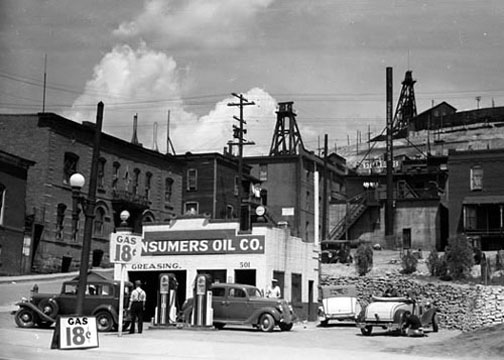 A Consumers Oil Company Gas Station in Butte Montana. This is a 1939 photo, notice the mid 30’s Ford at the pump, the mining steeples in background, and the old Butte street light out in front.
There are also 2 decorative brand globes on the roof line of the building and 18 cent gas seems to be a hot item. The pumps must be the latest version for the time, they appear quite modern.
How many cars can you count in the photo, there are six. Notice the Model A roadster is getting some tire work done, there is a person kneeling by the rear wheel
A Consumers Oil Company Gas Station in Butte Montana. This is a 1939 photo, notice the mid 30’s Ford at the pump, the mining steeples in background, and the old Butte street light out in front.
There are also 2 decorative brand globes on the roof line of the building and 18 cent gas seems to be a hot item. The pumps must be the latest version for the time, they appear quite modern.
How many cars can you count in the photo, there are six. Notice the Model A roadster is getting some tire work done, there is a person kneeling by the rear wheel
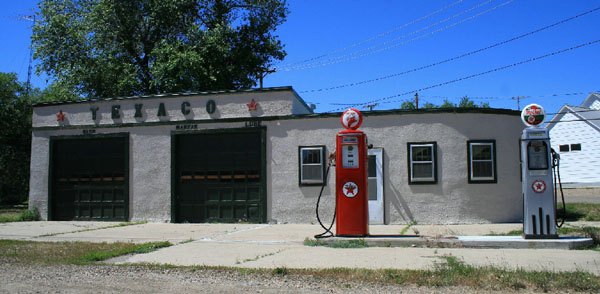 A Texaco Station in Glendive, Montana, looks very nostalgic, but may not be real old. Possibly just from the 1960’s.
It is not operating, but looks like all it needs is a couple of attendants, one to pump gas, and one to change oil and do minor service work,
A Texaco Station in Glendive, Montana, looks very nostalgic, but may not be real old. Possibly just from the 1960’s.
It is not operating, but looks like all it needs is a couple of attendants, one to pump gas, and one to change oil and do minor service work,
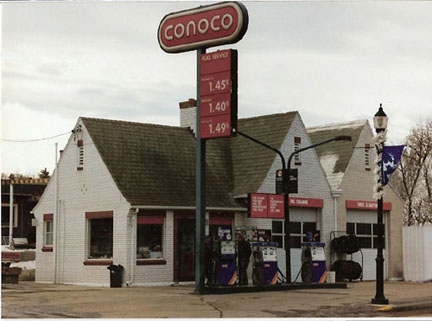 Rainbow (Joe’s) Conoco in Shelby, Montana.
This station is on the National Register of Historic Places, the photo is recent and from the light pole decorations it was taken in the early winter.
The building design is a classic Conoco gas station adapted “English cottage-type” design and was built in 1936. Finished with glazed off-white bricks with orange-red brick trim. It is one of the Montana’s oldest continuously operated outlets.
Stations of this design were in many locations, probably almost all of them have been removed or altered for another use and become a challenge to recognize.
Did you notice there are two attendants waiting for business by the left gas pump?
Rainbow (Joe’s) Conoco in Shelby, Montana.
This station is on the National Register of Historic Places, the photo is recent and from the light pole decorations it was taken in the early winter.
The building design is a classic Conoco gas station adapted “English cottage-type” design and was built in 1936. Finished with glazed off-white bricks with orange-red brick trim. It is one of the Montana’s oldest continuously operated outlets.
Stations of this design were in many locations, probably almost all of them have been removed or altered for another use and become a challenge to recognize.
Did you notice there are two attendants waiting for business by the left gas pump?
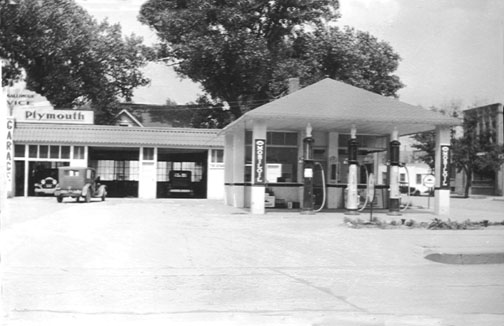 The Mobiloil-White Eagle Gas Station is in Pierre, South Dakota. This was a major gas station in South Dakota’s capitol city in the 1930’s.
It had Mobiloil signs, but each pump had a white eagle on top. Each of the pumps had a glass cylinder on top into which the gas was pumped before being distributed into a car. In the earlier pumps this glass tank was filled by a hand pump early each day so the sun could warm and expand the gas. The gas ran down into the auto gas tank with gravity and was sold by volume based on the glass container markings.
The Mobiloil-White Eagle Gas Station is in Pierre, South Dakota. This was a major gas station in South Dakota’s capitol city in the 1930’s.
It had Mobiloil signs, but each pump had a white eagle on top. Each of the pumps had a glass cylinder on top into which the gas was pumped before being distributed into a car. In the earlier pumps this glass tank was filled by a hand pump early each day so the sun could warm and expand the gas. The gas ran down into the auto gas tank with gravity and was sold by volume based on the glass container markings.
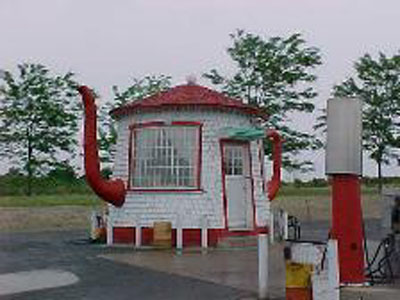 The Teapot Gas Station in Zillah, Washington is one of a kind.
One night in the 1920’s a group of friends in Zillah Washington, were drinking moonshine, and talking politics. Their talk included the then current government scandal over the Teapot Dome oil field in Wyoming. This chance gathering led to the building of a Teapot (Dome) gas station in Zillah Washington about 15 miles out of Yakima now on I-82. This station was still standing, but not in operation a few years ago when several car collectors from Montana made it a point to drive by and take photos.
It is listed on the National Register of Historical Places, so it may
be preserved for a time.
The Teapot Gas Station in Zillah, Washington is one of a kind.
One night in the 1920’s a group of friends in Zillah Washington, were drinking moonshine, and talking politics. Their talk included the then current government scandal over the Teapot Dome oil field in Wyoming. This chance gathering led to the building of a Teapot (Dome) gas station in Zillah Washington about 15 miles out of Yakima now on I-82. This station was still standing, but not in operation a few years ago when several car collectors from Montana made it a point to drive by and take photos.
It is listed on the National Register of Historical Places, so it may
be preserved for a time.
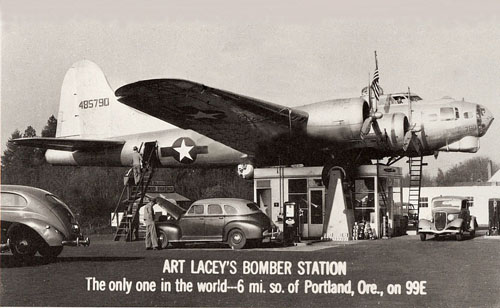 A World War II B-17 Bomber became a one of a kind,gas
A WWII veteran, Art Lacey, bought a surplus B-17, from a long line of them in Oklahoma that were war surplus for $15,000 and set out to fly it to Portland. Flying alone he crashed in a practice flight because there was no one to crank the wheels down when landing. He was told to just take another because they had so many.
After following railroad tracks at times of no visibility in a snow storm he arrived in Portland. Then the problem of moving it from the airfield to the gas station site loomed up. After being denied a permit to haul it on the highway, he moved it late one night, and got a $10 ticket for having too wide a load.
It became a gas station in 1947 and lasted until 1991.
A few years ago it was still standing and served as an ad
A World War II B-17 Bomber became a one of a kind,gas
A WWII veteran, Art Lacey, bought a surplus B-17, from a long line of them in Oklahoma that were war surplus for $15,000 and set out to fly it to Portland. Flying alone he crashed in a practice flight because there was no one to crank the wheels down when landing. He was told to just take another because they had so many.
After following railroad tracks at times of no visibility in a snow storm he arrived in Portland. Then the problem of moving it from the airfield to the gas station site loomed up. After being denied a permit to haul it on the highway, he moved it late one night, and got a $10 ticket for having too wide a load.
It became a gas station in 1947 and lasted until 1991.
A few years ago it was still standing and served as an ad
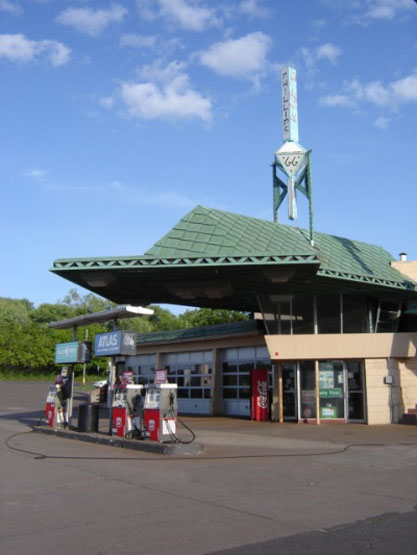 The R.W. Lindholm, Phillips 66 Service Station, in Cloquet, Minnesota was built in 1956. Its design is derived from the Broadacre Standardized Overhead Service Station which was designed as part of the Broadacre City project in the 1930s. Broadacre City was Wright’s utopian plan for a future city at anywhere USA.
Cloquet, Minnesota has the only gas station ever designed by Frank Lloyd Wright. The original design showed overhead fuel lines rather than on the ground pumps. The glass area on the second floor was intended to be a customer lounge, back in the days when motoring was a more leisurely activity and when there were always attendants to fill the tank and wash the windows.
The initial building was reported to cost $20,000 to build rather than the $5,000 common for the ordinary style station in the 1950’s. It recently received a major $150,000 renovation.
The station was added to the National Register of Historic Places in 1985
The R.W. Lindholm, Phillips 66 Service Station, in Cloquet, Minnesota was built in 1956. Its design is derived from the Broadacre Standardized Overhead Service Station which was designed as part of the Broadacre City project in the 1930s. Broadacre City was Wright’s utopian plan for a future city at anywhere USA.
Cloquet, Minnesota has the only gas station ever designed by Frank Lloyd Wright. The original design showed overhead fuel lines rather than on the ground pumps. The glass area on the second floor was intended to be a customer lounge, back in the days when motoring was a more leisurely activity and when there were always attendants to fill the tank and wash the windows.
The initial building was reported to cost $20,000 to build rather than the $5,000 common for the ordinary style station in the 1950’s. It recently received a major $150,000 renovation.
The station was added to the National Register of Historic Places in 1985
 Frank L Wright
Frank L Wright
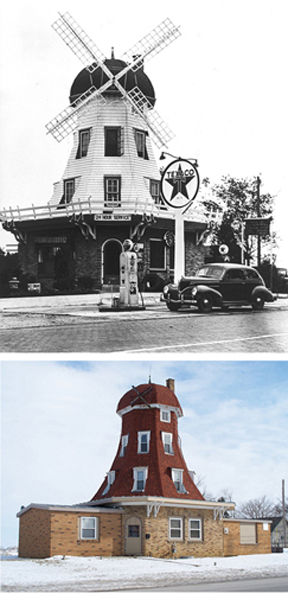 The location of this Dutch Mill gas station was not specified, when the top photo was found but was obviously operational as a Texaco station in the 1940’s. It is included here to illustrate a popular building style not common in Montana.
There were many Dutch Mill structures built for commercial purposes across the US during the early 1900’s. They were located all the way from Washington and California to the East Coast. Some have been converted to uses different from their initial purpose, but most have vanished. I wonder what they would have felt like if turned into a residential home, probably not a very good location when they were originally intended to be commercial.
The lower photo that was found totally separate from the first one shows “what happens to old gas stations that the interstate bypasses” and was identified in the photo as being in Carey, Ohio.
It turns out this Dutch Mill survived at Carey Ohio, 40 miles south of Toledo, and about halfway to Columbus. Careful comparison of the brick by the door in the two photos and the building itself, ensures that they are certainly the same building and located at Carey, Ohio. Carey was founded in 1843 now has a population of under 4000. The building does not appear to have any particular use now, but it has had 2 additions, a poor remodel, and the windmill blades have been severely “downsized”.
The location of this Dutch Mill gas station was not specified, when the top photo was found but was obviously operational as a Texaco station in the 1940’s. It is included here to illustrate a popular building style not common in Montana.
There were many Dutch Mill structures built for commercial purposes across the US during the early 1900’s. They were located all the way from Washington and California to the East Coast. Some have been converted to uses different from their initial purpose, but most have vanished. I wonder what they would have felt like if turned into a residential home, probably not a very good location when they were originally intended to be commercial.
The lower photo that was found totally separate from the first one shows “what happens to old gas stations that the interstate bypasses” and was identified in the photo as being in Carey, Ohio.
It turns out this Dutch Mill survived at Carey Ohio, 40 miles south of Toledo, and about halfway to Columbus. Careful comparison of the brick by the door in the two photos and the building itself, ensures that they are certainly the same building and located at Carey, Ohio. Carey was founded in 1843 now has a population of under 4000. The building does not appear to have any particular use now, but it has had 2 additions, a poor remodel, and the windmill blades have been severely “downsized”.